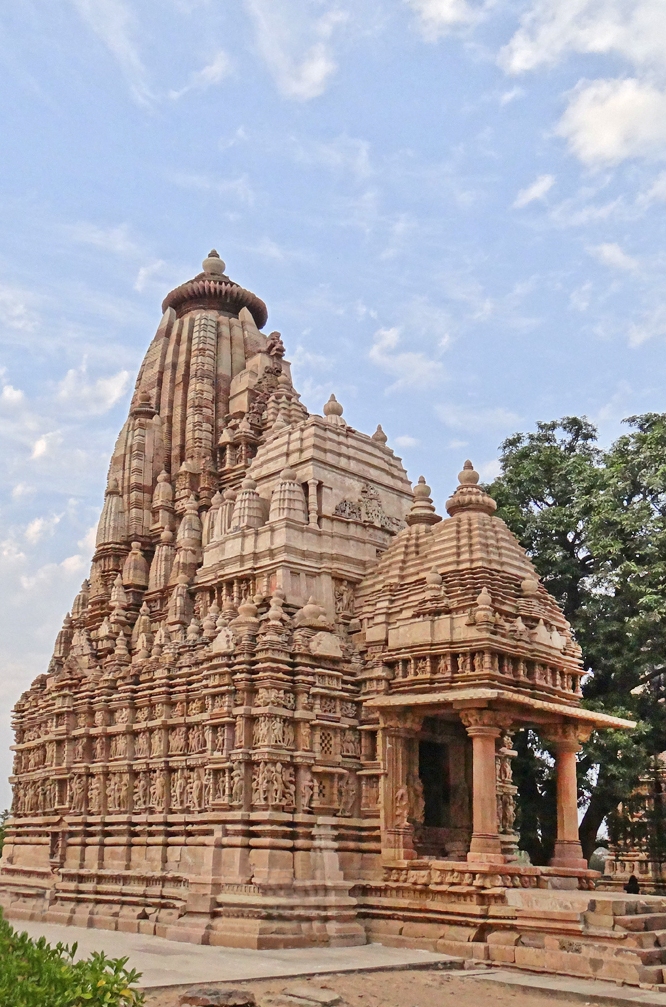Khajuraho Bhagwan Parshvanatha Digamber Jain Mandir, Madhya Pradesh

Address
Khajuraho Bhagwan Parshvanatha Digamber Jain Mandir Eastern Group of Temples, Sevagram, Khajuraho, Madhya Pradesh 471606
Diety
Bhagwan Parshvanatha
Introduction
Parshvanatha temple (Pārśvanātha Mandir) is a 10th-century Jain temple at Khajuraho in Madhya Pradesh, India. It is now dedicated to Parshvanatha, although it was probably built as an Adinatha shrine during the Chandela period. Despite the temple’s Jain affiliation, its exterior walls feature Vaishnavaite themes. The entrance has an inscription with a most-perfect magic square. The temple sculptures are dilapidated condition. It is part of a UNESCO World Heritage Site along with other temples in the Khajuraho Group of Monuments.
Puranic Significance
The temple is believed to have been constructed by a prominent Jain family between 950 and 970 CE, during the reign of the Chandela king Dhanga. A 954 CE (1011 VS) inscription on the left door jamb of the temple records gifts and endowments of gardens by one Pahila. The inscription describes Pahila as a devotee of Jinanatha and states that he was held in great esteem by the king Dhanga. The earliest idol enshrined in the temple appears to have been that of Adinatha. When the British archaeological surveyor Alexander Cunningham visited in 1852, he found the main sanctum deserted. He described it as “Jinanatha temple” and wrote that it had been repaired by a Jain banker in 1847. In 1860, a Parshvanatha idol was installed in the main sanctum. An Adinatha statue was placed in a secondary shrine attached to the rear of the temple. The Adinatha and other Tirthankara hand are broken. The temple has been classified as a Monument of National Importance by the Archaeological Survey of India.
Special Features
The Parshvanatha temple is the largest among the Jain temples of Khajuraho. It has an entrance porch, a small hall, a large hall (mandapa), a vestibule, and a sanctum. The temple structure has an oblong architectural plan with projections at two ends. The front (eastern) projection forms the entrance porch, the back (western) projection is a shrine attached to the sanctum. The ceiling of the entrance porch features chain and floral patterns, and a pair of intertwined flying vidyadharas. The door-lintel of the mandapa has the sculpture of Adinatha’s attendant: a ten-armed Chakreshvari riding a Garuda. The sanctum features sculptures of the Jinas. Despite the temple’s Jain affiliation, the outer walls also depict Vaishnavite themes including sculptures of Hindu gods and their incarnations with their consorts. These include Vishnu-Lakshmi, Rama-Sita, Balarama Revati, Parashurama, Hanuman, Brahma and Yamalarjuna legend of Krishna. These sculptures are similar to those of the Lakshmana Temple in modeling, proportions and poise. Unlike the Lakshmana temple, the Parshvanatha temple doesn’t feature explicit erotic sculptures, although one particular image appears to show a cross-legged apsara masturbating with an object.
Century/Period/Age
10th-century
Managed By
UNESCO World Heritage Site & Archaeological Survey of India
Nearest Bus Station
Sevagram
Nearest Railway Station
Khajuraho
Nearest Airport
Khajuraho




